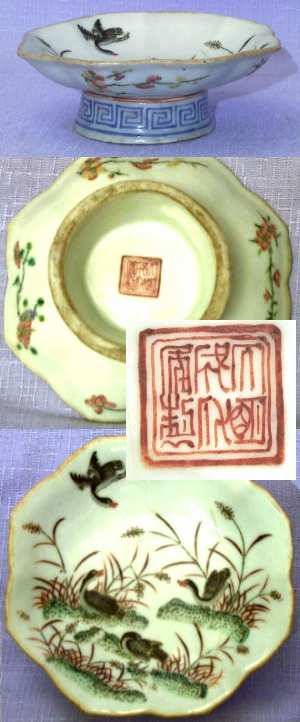
This page is only one of many thousands of Gotheborg.com Help and Information Pages, offering specialized knowledge on Chinese and Japanese Porcelain, including a Glossary, Q&A, Chinese and Japanese Porcelain Marks, Chinese Porcelain Exhibition and Excavation reports etc. For personal help and far more information, join our Discussion Board or use 'Ask a Question' for quick email consultations. For full text and better navigation, use a full-screen device rather than a mobile phone, that offers only limited content.

This fencai enamel decorated porcelain basin is a rare and typical example of the porcelain made during the short Hsien Feng period. Its measures are 5-1/4" in diameter and it sits 1-7/8" high.
The thick porcelain, the thin gilt rim border and the light blue fret pattern are typical of the few pieces found from this period.
What pieces found at all, must be cherished for their historical importance rather then their qualilty since during this period, the Imperial kilns in Jingdezhen was destroyed and the area devastated by the Taiping rebellion 1851-64.
This rather unusual mark found on this basin, which says "Da Ming Chenghua Nian Zhi" (Made under the Ming Chenghua Period) is therefore probably connected to the fact that the porcelain kilns in the Jiangxi province now was cut off from the Qing court in the North of China.
During this period any piece bearing a Qing dynasty period mark could be interpreted as a sign of rebellion, treason or an effort to overthrow the ruling Taipings. The punishment for this crime would be a the brutal Execution of the Nine Relatives, counting: father, son, husband, wife, elder brother/sister, younger brother/sister, close relatives of accused, close relatives of accuseds spouse, close friends of accused.
Most likely the Jingdezhen potters were sensible enough not to take this risk.
Probably "Da Ming Chenghua Nian Zhi" was as far as the potters would go.
Thank you for your interest.
Best regards,
Jan-Erik Nilsson
The translation of the mark and historical insights, courtesy of Simon Ng, City University of Hong Kong.